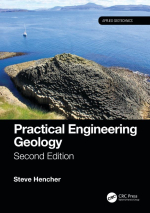Добрый день, Коллеги. Важное сообщение, просьба принять участие. Музей Ферсмана ищет помощь для реставрационных работ в помещении. Подробности по ссылке
Practical engineering geology / Практическая инженерная геология
The engineering geologist should be able to identify soil and rocks by visual examination and to interpret the geological history and structure of a site as set out in Chapter 4. He needs to be able to describe these rocks and soils both geologically and, in an unambiguous way, in terms of their relative strengths. He also must have knowledge of geomorphological processes, be able to interpret terrain features and hydrogeological conditions. Principles of hydrogeology are dealt with in Chapter 5.
Engineering geologists can often make important contributions at the beginning of a project in outline planning and design of the investigation for a site. He should be familiar with the ground investigation techniques that are available and that suit the ground conditions, so that a site can be characterised cost-effectively and thoroughly, as set out in Chapter 6. He also needs to understand the way that soils and rocks behave mechanically under load, in response to fluid pressures and chemically and how to investigate their properties (Chapter 7). Much of this will not be taught in an undergraduate degree and needs to be learnt through MSc studies or through Continuing Professional Development (CPD), including self-study and from experience gained “on the job”. <...>




